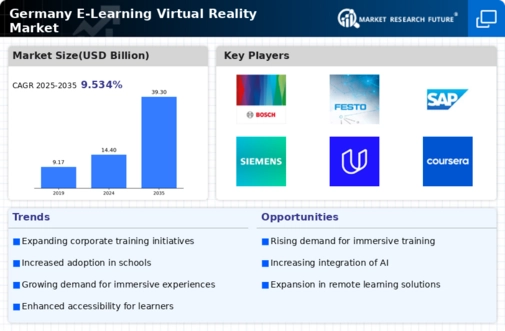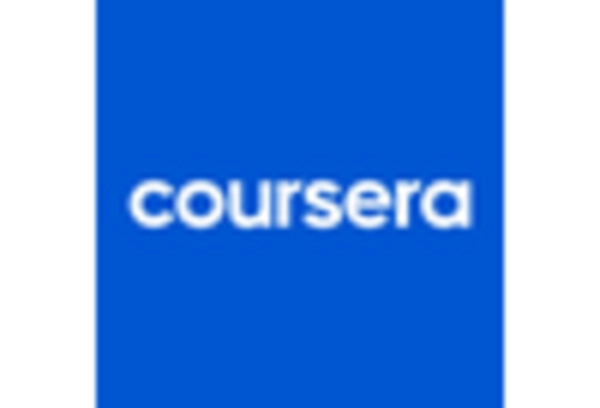Technological Advancements in VR
The e learning-virtual-reality market is experiencing a surge due to rapid technological advancements in virtual reality (VR) hardware and software. Innovations such as improved graphics, enhanced interactivity, and more affordable VR headsets are making immersive learning experiences more accessible. In Germany, the market for VR hardware is projected to grow at a CAGR of 25% over the next five years, indicating a strong demand for VR solutions in educational settings. This technological evolution not only enhances user engagement but also facilitates personalized learning experiences, which are crucial in the e learning-virtual-reality market. As educational institutions and corporate training programs increasingly adopt these technologies, the potential for growth in this sector appears substantial.
Increased Focus on Skill Development
The e learning-virtual-reality market is being propelled by an increased focus on skill development across various sectors. In Germany, industries are recognizing the need for continuous training and upskilling of employees to remain competitive. VR provides a unique platform for immersive training simulations, allowing learners to practice skills in a safe environment. Reports suggest that companies investing in VR training solutions can see a 30% improvement in employee performance. This emphasis on skill enhancement is likely to drive the adoption of VR technologies in corporate training programs, thereby expanding the e learning-virtual-reality market. The ability to create realistic training scenarios positions VR as a valuable tool for workforce development.
Support from Educational Institutions
The e learning-virtual-reality market is receiving substantial support from educational institutions that are increasingly recognizing the value of immersive learning experiences. In Germany, many universities and colleges are incorporating VR into their curricula to enhance student engagement and learning outcomes. This institutional backing is crucial, as it not only legitimizes the use of VR in education but also encourages investment in related technologies. Reports indicate that educational institutions that adopt VR technologies can improve student satisfaction rates by up to 40%. This trend of institutional support is likely to foster further growth in the e learning-virtual-reality market, as more schools and universities seek to innovate their teaching methods.
Rising Demand for Remote Learning Solutions
The e learning-virtual-reality market is significantly influenced by the rising demand for remote learning solutions. As educational institutions and businesses seek to provide flexible learning options, VR offers an immersive alternative that can replicate in-person experiences. In Germany, a survey indicates that 70% of educators believe that VR can enhance remote learning by providing interactive and engaging content. This shift towards remote learning is likely to drive investments in VR technologies, as organizations aim to improve learning outcomes and student engagement. The potential for VR to bridge the gap between traditional and remote education makes it a pivotal driver in the e learning-virtual-reality market.
Growing Interest in Gamification of Learning
The e learning-virtual-reality market is benefiting from the growing interest in gamification as a method to enhance learning experiences. Gamification incorporates game-like elements into educational content, making learning more engaging and enjoyable. In Germany, studies show that learners are 50% more likely to retain information when it is presented in a gamified format. This trend is encouraging educational institutions and training providers to integrate VR with gamification strategies, thereby increasing the appeal of their programs. As the demand for interactive and enjoyable learning experiences rises, the e learning-virtual-reality market is likely to see significant growth driven by this innovative approach.

















Leave a Comment